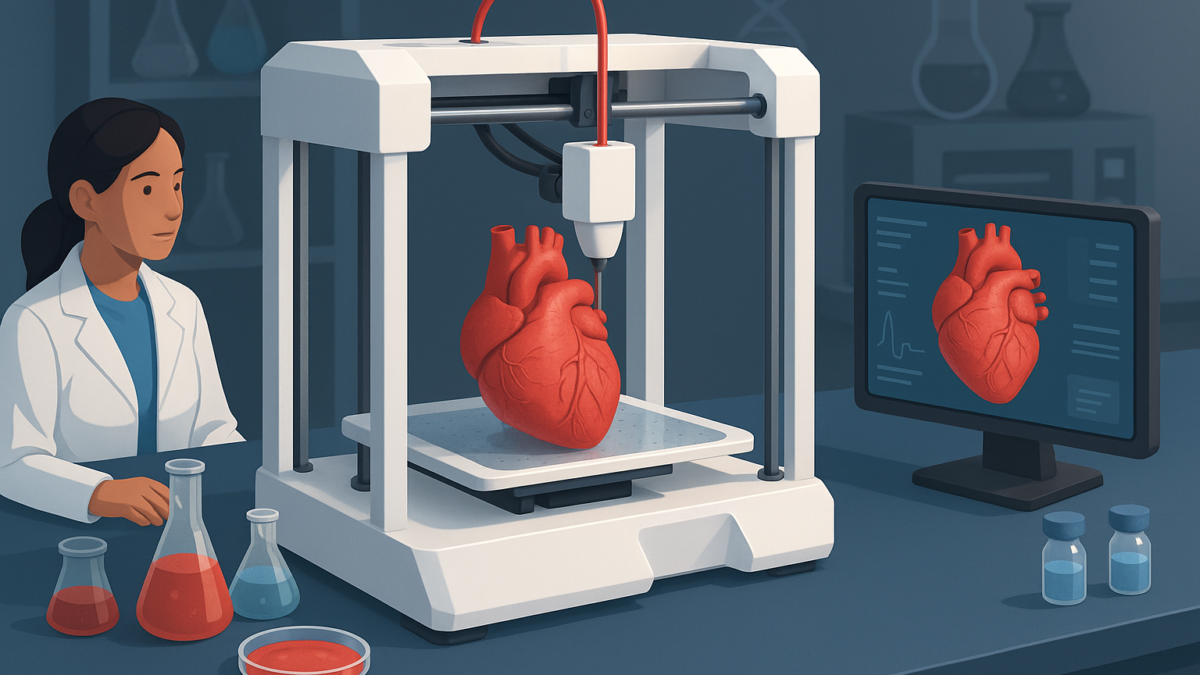3D Bioprinting in Regenerative Medicine: The Future of Organ Repair
Imagine a world where patients in need of organ transplants no longer face years-long waiting lists. Instead, a custom-built, lab-grown organ could be printed on demand. This once futuristic concept is becoming reality through 3D bioprinting, one of the most groundbreaking advances in regenerative medicine.
In 2025, scientists and medical innovators are pushing the boundaries of what’s possible, using living cells and biomaterials to create functional tissue structures. From repairing damaged cartilage to the dream of printing fully functional organs, 3D bioprinting is set to revolutionize healthcare and redefine the future of organ repair.
What Is 3D Bioprinting?
3D bioprinting is the process of using bio-inks—a mix of living cells, biomaterials, and growth factors—to print three-dimensional tissue structures. Similar to traditional 3D printing, bioprinters deposit layers of bio-inks to create tissue-like structures that mimic the human body.
Unlike prosthetics or mechanical implants, these bioprinted tissues are biologically compatible with the patient, reducing the risks of rejection and complications.
Why It Matters in Regenerative Medicine
Organ shortages remain one of the greatest challenges in modern medicine. According to the World Health Organization, thousands of patients worldwide die each year waiting for organ transplants. 3D bioprinting offers hope by:
- Reducing Transplant Waiting Lists: Potential to create organs on demand.
- Lowering Risk of Rejection: Custom tissues made from the patient’s own cells.
- Supporting Drug Testing: Bioprinted tissues provide safer models for testing new therapies.
- Advancing Personalized Medicine: Tailored treatments specific to individual patient needs.
Breakthroughs in 3D Bioprinting (2025)
1. Bioprinted Skin & Cartilage
Researchers have already achieved success in printing skin grafts for burn victims and cartilage for joint repair. These breakthroughs are transforming reconstructive surgery.
2. Vascularized Tissues
One of the biggest hurdles has been creating tissues with working blood vessels. In 2025, progress in vascularized bioprinting is making it possible to sustain larger and more complex tissue structures.
3. Mini-Organs (“Organoids”)
Scientists are now creating miniature versions of organs, such as liver organoids for drug testing and kidney models for disease research. While not full organs yet, they are vital steps toward scalable organ repair.
4. Toward Whole Organs
The ultimate goal—bioprinting fully functional organs such as hearts, kidneys, and livers—is still in development. However, rapid progress suggests it may move from science fiction to medical practice within the next decade.
Benefits for Patients and Healthcare Systems
- Faster Recovery: Bioprinted tissues reduce complications and recovery times.
- Affordable Healthcare: In the long run, scalable bioprinting could lower the cost of transplants.
- Ethical Advantages: Reduced dependency on human donors and animals for testing.
- Improved Accessibility: Opens opportunities for patients in regions with limited donor availability.
Challenges That Remain
Despite remarkable progress, 3D bioprinting faces obstacles:
- Scalability: Moving from lab to hospital requires mass-production capabilities.
- Regulatory Approval: Strict testing is required before clinical use of bioprinted organs.
- Cost: Cutting-edge equipment and materials are still highly expensive.
- Complexity: Replicating fully functional organs like hearts and kidneys remains a scientific challenge.
The Future of Organ Repair with 3D Bioprinting
By the 2030s, experts predict we could see routine clinical use of bioprinted tissues and organs. Hospitals may have dedicated 3D bioprinting labs, producing patient-specific grafts, patches, and even organs within days.
This shift won’t just transform patient outcomes—it will redefine healthcare supply chains, research, and ethical debates around organ transplantation.
At MedTechMunch, we’ve also covered emerging wearable health tech trends—another critical area where technology is redefining patient care. Together, these innovations demonstrate how digital health, bioprinting, and AI are shaping the future of medicine.
For B2B marketers in healthcare technology, distributing whitepapers on such topics can accelerate reach and engagement. If you’re looking to amplify your thought leadership, check out iTMunch’s B2B Content Syndication Services to target the right audience with the right content.
Conclusion
3D bioprinting is not just an incremental step—it’s a giant leap for regenerative medicine. From skin grafts and cartilage repair to the eventual goal of printing fully functional organs, this technology is reshaping the way we think about healing and repair.
In the coming years, as advancements accelerate and regulations adapt, 3D bioprinting may eliminate transplant waiting lists and offer personalized, life-saving treatments at scale.
The future of organ repair is no longer a distant dream—it’s being printed layer by layer, today.





